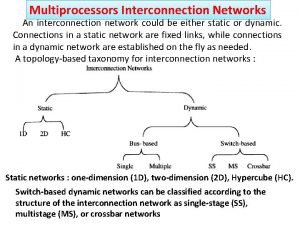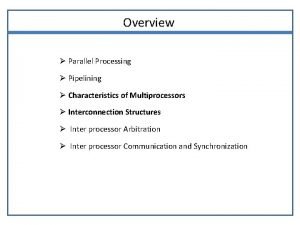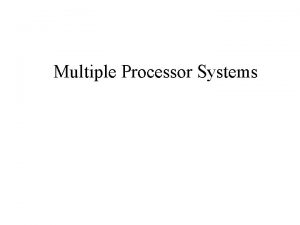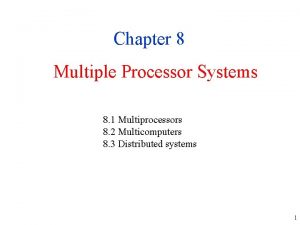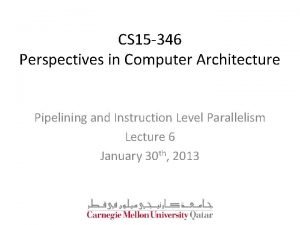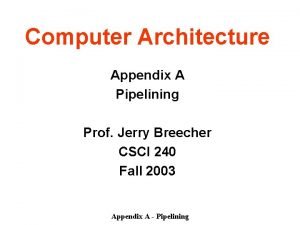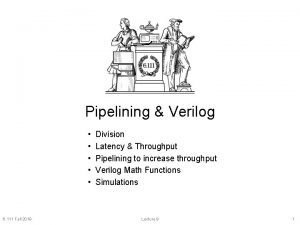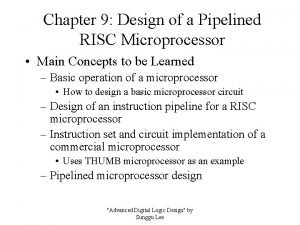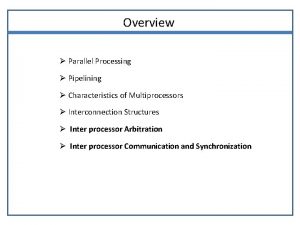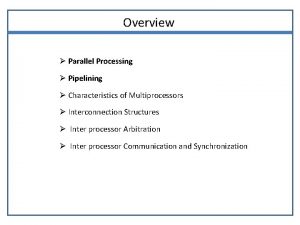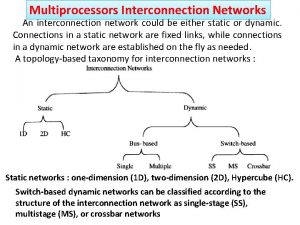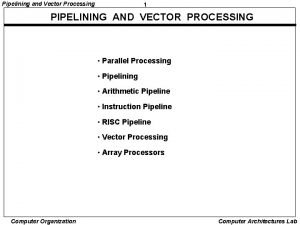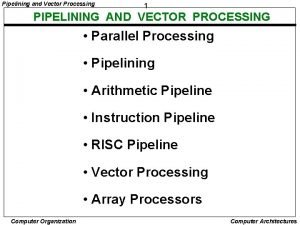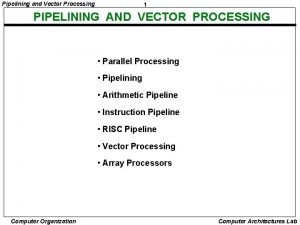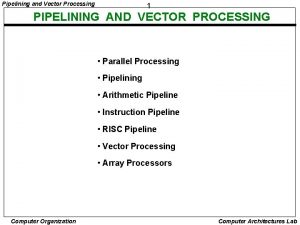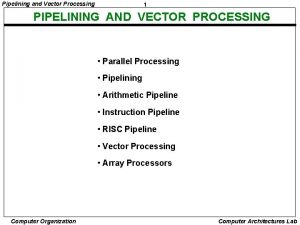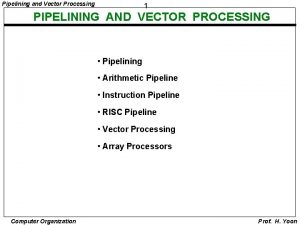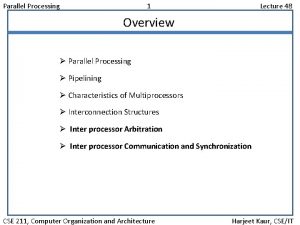Overview Parallel Processing Pipelining Characteristics of Multiprocessors Interconnection



















- Slides: 19

Overview Ø Parallel Processing Ø Pipelining Ø Characteristics of Multiprocessors Ø Interconnection Structures Ø Inter processor Arbitration Ø Inter processor Communication and Synchronization

Multiprocessors Ø A multiprocessor system is an interconnection of two or more CPUs with memory and input-output equipments Ø Multiprocessors are classified as Multiple Instruction stream, multiple data stream (MIMD) systems Ø Multiprocessor and Multicomputer Ø Ø Similarity : both support concurrency Ø Difference : multiprocessor controlled by one OS. Emergence of microprocessor led to multiprocessor. Ø Microprocessor take very little physical space and inexpensive Ø VLSI technology has reduced cost of computer components that multiple processor became attractive design possibility for meet system performance requirement

Multiprocessors Ø Multiprocessing improves the reliability of the system (fault tolerant) Ø The benefit from multiprocessor organization is improved system performance. Ø The system derives its high performance from the fact that computation can be processed in parallel in one of the two ways: Ø Multiple Independent jobs can be made to operate in parallel Ø A single job can be partitioned into multiple parallel task - Ex: One processor –high speed computation, other- data processing task Ø The compiler checks the data dependency in the program. Two parts of a program that do not use data generated by each can run concurrently

Coupling of Processors Multiprocessors are classified by the way their memory is organized. Tightly Coupled System / Shared Memory System - Multiprocessor system with common shared memory - Tasks and/or processors communicate in a highly synchronized fashion - Communicates through a common global shared memory Loosely Coupled System / Distributed Memory System - Each processor element has its own private local memory - Tasks or processors do not communicate in a synchronized fashion - Communicates by message passing packets - Overhead for data exchange is high - Most efficient when interaction between task is minimum

Memory Shared (Global) Memory - A Global Memory Space accessible by all processors - Processors may also have some local memory Distributed (Local, Message-Passing) Memory - All memory units are associated with processors - To retrieve information from another processor's memory a message must be sent there Uniform Memory - All processors take the same time to reach all memory locations Nonuniform (NUMA) Memory - Memory access is not uniform SHARED MEMORY Memory DISTRIBUTED MEMORY Network Processors/Memory

Shared Memory Multiprocessors M M . . . M Buses, Multistage IN, Crossbar Switch Interconnection Network P P . . . P Characteristics All processors have equally direct access to one large memory address space Limitations Memory access latency; Hot spot problem

Message Passing Multi. Processors Point-to-point connections Message-Passing Network P P . . . P M M . . . M Characteristics - Interconnected computers - Each processor has its own memory, and communicate via message-passing Limitations - Communication overhead; Hard to programming

Interconnection Structure The components that form a multiprocessor systems are CPUs, IOPs connected to input-output devices and a memory unit that may be partitioned into a separate modules. The interconnection between components can have different physical configuration based on no. of transfer path b/w processor and memory. Some of the schemes are : (1). Time-Shared Common Bus (2). Multiport Memory (3). Crossbar Switch (4). Multistage Switching Network (5). Hypercube System

Time-Shared Common Bus - Consists of no. of processors connected through a common path to memory unit - Memory access is fairly uniform, but not very scalable ØOnly one processor can communicate with the memory or another processor at any given time Ø when one processor is communicating with the memory, all other processors are either busy with internal operations or must be idle waiting for the bus

Time-Shared Common Bus Ø The system may exhibit transfer bus transfer conflict which must be resolved by incorporating a bus controller that establishes priorities among the resulting request ØThe processor can be kept busy through the implementation of two or more independent buses to permit multiple simultaneous bus transfer ØSystem bus controller is used to link each local bus to common system bus ØOnly one processor can communicate with the shared memory at any given time Ø The other processors are kept busy communicating with their local memory and I/O devices

System Bus Structure for Multiprocessor Local Bus Common Shared Memory System Bus Controller CPU IOP System Bus Controller CPU Local Memory SYSTEM BUS System Bus Controller CPU Local Bus IOP Local Memory Local Bus Local Memory

Multi Port Memory - It employs separate buses between each memory module and each CPU Multiport Memory Module - Each port serves a CPU Memory Module Control Logic - Each memory module has control logic - Resolve memory module conflicts Fixed priority among CPUs Advantages - Multiple paths -> high transfer rate Disadvantages - Memory control logic - Large number of cables and connectors CPU 1 CPU 2 CPU 3 CPU 4 Memory Modules MM 1 MM 2 MM 3 MM 4

Cross Bar Switch MM 1 MM 2 MM 3 MM 4 CPU 1 CPU 2 CPU 3 CPU 4 It consists of number of crosspoints that are placed at intersections between Processor buses and memory module paths -Switch examines the address that is placed in bus to determine whether its particular module is being addressed -Also resolves multiple request for access to same memory module on predefined priority basis

Cross Bar Switch MM CPUs Priority levels are established by arbitration logic to select one CPU when two or more CPUs attempt to access the same memory

Multi Stage Switching Network Basic component of multistage network is 2 i/p, 2 o/p Interchange Switch 0 A 1 B A connected to 1 0 1 B B connected to 0 1 B A connected to 0 A 0 A 1 B B connected to 1 ØIf input A and B both request the same output terminal only one of them will be connected and other will be blocked

Multi. Stage Interconnection Network Binary Tree with 2 x 2 Switches 0 0 1 1 0 P 1 P 2 0 1 1 0 1 000 001 010 011 100 101 110 111 -Two processors connected through switches to 8 memory modules -Path from source to destination is determined from binary bits of destination number -Drawback : certain request patterns cannot be satisfied simultaneously, i. e if P 1 connected to any of (000 -011 ) then P 2 can only be connected to one of (100 -111)

Multi. Stage Interconnection Network 8 x 8 Omega Switching Network 0 1 000 001 2 3 010 011 4 5 100 101 6 7 110 111 - There is exactly one path from each source to any particular destination - Disadvantage : some request pattern cannot be connected e. g. connection simultaneously to destination 000 and 001

Hypercube Interconnection Hypercube of binary n-cube multiprocessor structure is a loosely coupled system Composed of N=2 n processors interconnected in an n-dimensional binary cube n-dimensional hypercube (binary n-cube) - p = 2 n - processors are conceptually on the corners of a n-dimensional hypercube, and each is directly connected to the n neighboring nodes - Degree = n 011 111 010 0 11 01 110 101 001 1 One-cube 10 00 Two-cube 000 Three-cube 100

Hypercube Interconnection Ø Each node is assigned a binary address in such a way that the address of two neighbors differ in exactly 1 bit position Ø Routing messages through an n-cube structure may take from one to n links from a source node to a destination node Ø A routing procedure can be developed by computing the EX-OR of source node address with destination node address
 Multiprocessor and its characteristics
Multiprocessor and its characteristics Static interconnection network
Static interconnection network Parallel processing vs concurrent processing
Parallel processing vs concurrent processing Characteristics of vector processing
Characteristics of vector processing Uma multiprocessors using multistage switching networks
Uma multiprocessors using multistage switching networks Uma multiprocessors using crossbar switches
Uma multiprocessors using crossbar switches Pipelining adalah
Pipelining adalah Linear vs nonlinear pipelining
Linear vs nonlinear pipelining Pipelining in computer architecture examples
Pipelining in computer architecture examples Pipelining protocol
Pipelining protocol Pipelining and superscalar techniques
Pipelining and superscalar techniques Scalar pipeline vs superscalar pipeline
Scalar pipeline vs superscalar pipeline 4 segment instruction pipeline
4 segment instruction pipeline Pipeline adalah
Pipeline adalah Umich eecs 470
Umich eecs 470 Major hurdles of pipelining
Major hurdles of pipelining Principle of pipelining
Principle of pipelining Pipelining in verilog
Pipelining in verilog Collision prevention in computer architecture
Collision prevention in computer architecture Pipelining in 8086 microprocessor
Pipelining in 8086 microprocessor

